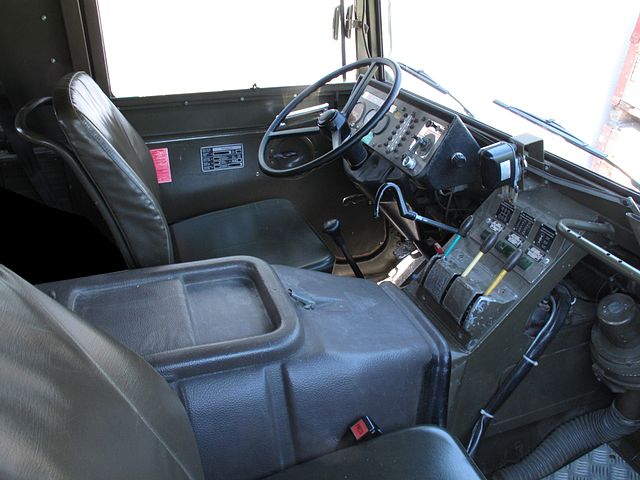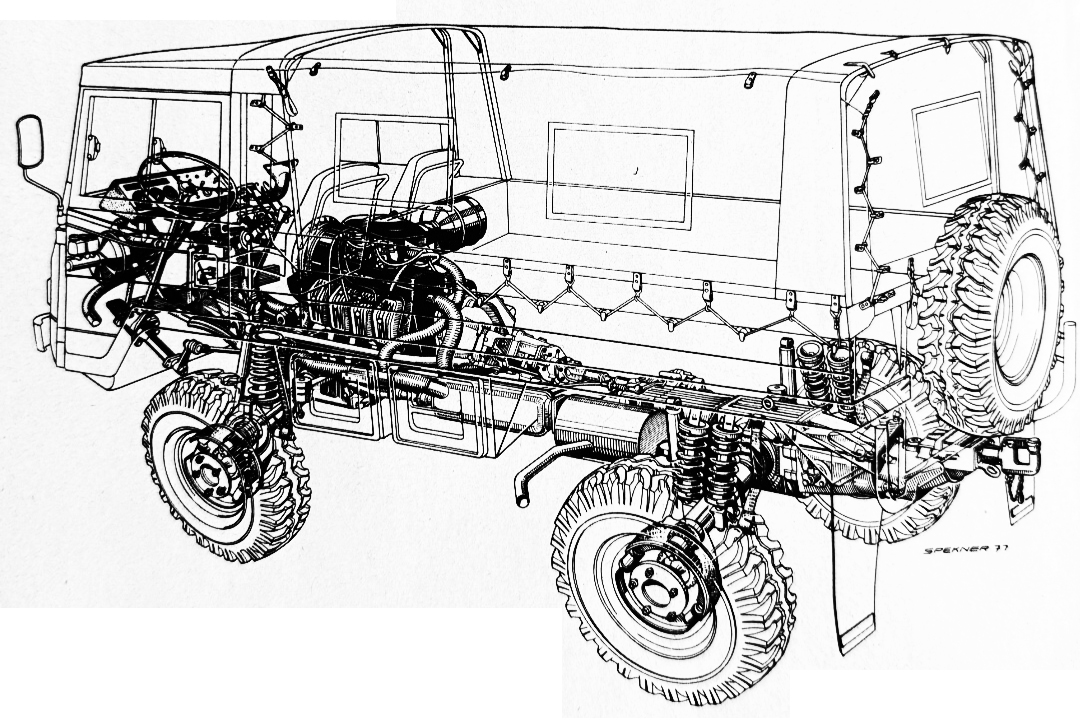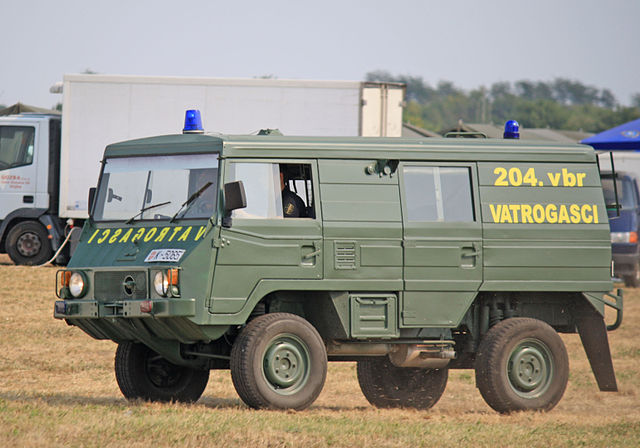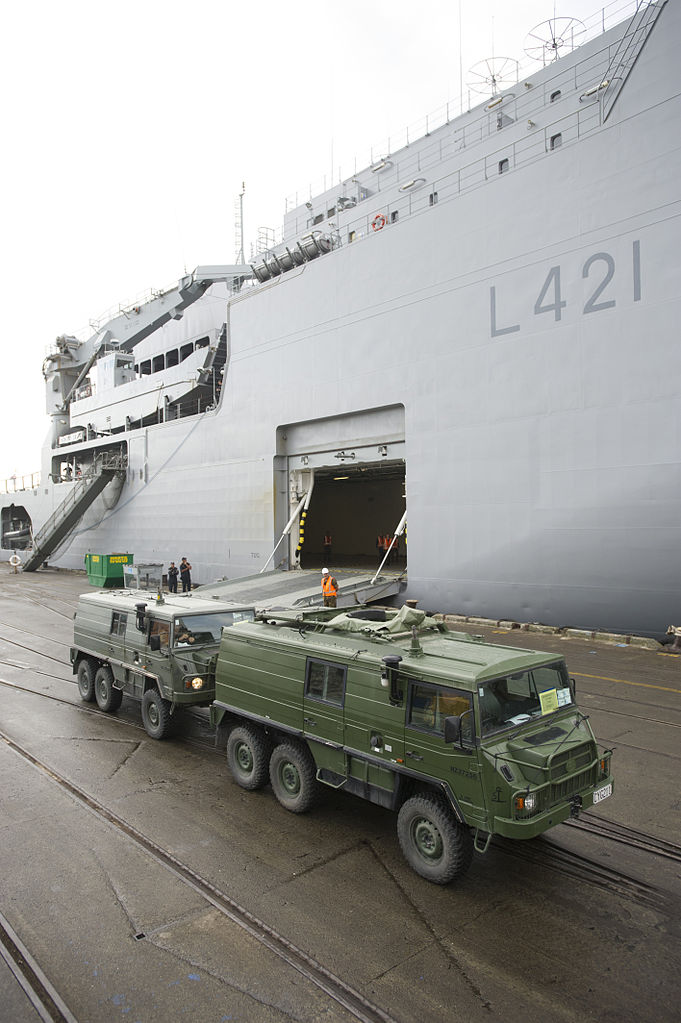Steyr-Puch Pinzgauer (1971)
 Austrian 4x4/6x6 light utility truck (18,349 produced 1971-2007)
Austrian 4x4/6x6 light utility truck (18,349 produced 1971-2007)
The Pinzgauer, superstar Austrian Military Truck
One of the 4x4 milestone trucks of post-war Europe was found in Austria. Designed much later than the German
Mercedes Unimog, this vehicle proceeded of a different path: Not simple a rugged off-road light utility truck mostly intended for agricultural work, but a replacement for the already existing Haflinger 700 AP 4×4 vehicle, from Steyr-Daimler-Puch in Graz. The name was of an Austrian breed of cattle (Austrian cow). It was produced to an extent of 18,350 until 2007, passed on BAE Systems Land & Armaments under licence in 2000, but production ceased in 2009.
Development
The precedessor, the Haflinger

The original Steyr-Daimler-Puch Haflinger 700 AP was a light 4×4 light military multi purpose offroad vehicle. The latter was an air-transportable, very light (600 kg (1322.8 lb), 500 kgs payload 3.5 m x 1.5 m vehicle powered by a 643 cc flat twin horizontally opposed, rear mounted, air-cooled engine.
Over 16,000 vehicles were manufactured, designed by Tatra's Erich Ledwinka and in 1959 when production started, was called the 'little Tatra'. Approximately 7,000 served with the Swiss, Austrian and Australian armies, plus Royal Navy. They saw action in Katanga and Congo in the 1960s and inspired the US M274 Mechanical Mule used in Vietnam.
Ten years after the start of the production, the Steyr-Puch company planned for its replacement, designing a heavier, bulkier, but still light variant, which original prototype was ready around late 1969 production starting in early 1971. The Pinzgauer was marketed as a successor of the Steyr-Daimler-Puch Haflinger (produced until 1971) in its first generation model, the 710 4x4 and the 712 6x6 developed around the same chassis, engine and powertrain in general.
Design (1965-1970)

Like the previous Haflinger, the truck had the caracteristic stamped steel boxy nose, but the engine, more powerful, was relocated behind the driver (not in front, making for an very short nose), and its chassis design contributed to its high mobility.
This was a central tube chassis, with a transaxle configuration, which distributing the weight more evenly. Like the Unimog, it kept its centre of gravity quite low, explaining ts ability to carry heavy loads on very uneven terrain without risk of toppling over.
Differentials were sealed units for the vehicle to ford rivers, requiring at that minimal additional lubrication. It also had portal axles like the Unimog for extra clearance.
The powerplant consisted in an inline 4-cylinder Steyr-designed petrol/gasoline engine, 2.5 litre inline and air-cooled, 2.7 L for final 712 variants; It was served by a five-speed manual transmission, with two-speed transfer case, the only difference between the two chassis were the four-wheel or six-wheel-drive, but both had on-the-fly hydraulic differential locks.
For performances, its boxy look did not helped achieving great coefficients, and the 1st generation vehicle's maximum speed, light, was around 110 km/h (68 mph)for the 710 and 100 km/h (62 mph) for the 712. Both had a radius of 400 km (249 mi).
 Dashboard interior
Dashboard interior

 portal axle
portal axle
Qualities and overview
The Pinzgauer emerged as one of the most capable all-terrain truck ever made in the cod war. Not supremely fast on road (at best 110 kph without load (68 mph)) due to its boxy look and high cx, it was still able to carry more troops han a Humvee, and appeared ti be even faster over rough terrain. The 710M for its small engine and four wheels would still carry a platoon, of 10 infantry, or two standard NATO pallets as payload. Tactical omobility was excellent due to their low weight, they could be heli-towed anywhere, by any model. Due to their highly placed engine and equally high chassis they were able to ford more than 1,10 m rivers without a intch.
Both the 4×4 and 6×6 not only had a generous payload, but their high torque unit proved capable of towing 5 tons (11,023 lb) on road, then 1,5 (3,307 lb) 1,8 tons (3,968 lb) off-road. The range of 400 kilometres (249 mi) was on a single fuel tan but it rose to 700 kilometres (435 mi) with the optional 125 litre tank.
It was also designed to be reliable and simple to repair and maintain. The air-cooled petrol engine and its dual-Zenith 36 mm NDIX carburetors were common on the civilian market and easy to procure. The engine however was designed for the vehicle and had an extra oil pump to never not got starved no matter its orientation. It was also surprisingly stable on a very high slope. The Generation II only improved on these qualities with a set of improvements and even better engines.
Production
After numerous major and minor issues being rectified, the final production vehicle was presented on May 17, 1971. Delivery to the army was ordered initially in 1970, and started in 1973. In the next decades,the Austrian Army received thousands of Pinzgauers in many versions: Basic tarpaulin top vehicle, panel van variant, flatbed, ambulance, AA gun carrier, workshop van, or with double cab, modified for fire department and rescue.
For training some were even converted as dummy tanks. Other were used on airport with a snow plow, and anothee as flag signal vehicle. In addition to the Austrian and German armies, it was widely exported. By the time production ended on February 23, 2000, around 24,000 “Pinzis” left the production line. The basic design was only changed once to install a more economical and more powerful engine.
Pinzgauer 710 4x4
⚙ Model 710 4x4 specifications |
| Dimensions | 4.175 x 1.760 x 2.045 m |
| Weight | 2500 kgs. |
| Crew | 1 driver + 8 passengers |
| Payload | 500 Kgs. |
| Propulsion | 4 cyl. Steyr 2.5 L 87 bhp, Gbx 5 speeds |
| Speed | 100-110 kph (62-68 mph) |
| Range | 400 km (249 mi) |
| Protection | None |
Pinzgauer 710K Minutia

The 710K was 4175 mm long, 1815 mm wide, and 2110 mm high for a curb weight of 2,5 ton with a payload of 500 kg, total weight of 3t. Its wheelbase of 2,2 m was well helped by a tall ground clearance. Turning circle was also good at 10,5 m with rear-wheel drive, 11,2 m with all-wheel drive. It was powerted by an air-cooled with axial fan Steyr-Daimler-Puch, 2.5 liter, 4-cylinder in-line, four-stroke, with carburetor, 2 valves per cylinder overhead, and actuated by the camshaft via pushrods and rocker arms. Bore was 92 mm and Stroke 94 mm, displacement 2499 cm³ with a compression ratio of 7.8:1.
The engine ran on Gasoline for 90 hp HP/kW or 66.2 kW DIN at 4000 rpm, and a max. torque of 185 Nm at 2000 rpm. Top speed is 96 km/h. Power transmission used a ZF S 5-18/3 Mechanical gearshift with all forward gears with lock-synchronized clutch. Reverse gear with dog clutch, 5 forward gears and one reverse gear and Stick shift. The Transfer case had a mechanical reduction and transfer case flanged to the central support tube and rear axle drive and featured two gears with lock-synchronized clutch. The Gearshift operation womprosed a white gear lever for the main transmission and a black gear lever for the range transmission. There was one lever each for the front-wheel drive, rear differential lock, front differential lock. The clutch was a Fichtel and Sachs with diaphragm single-disk dry clutch, 240 mm diameter, hydraulically operated.
The drive was either rear-wheel or all-wheel with the front-wheel drive hydraulically engaged and disengaged while driving. The axles tront and rear had independent wheel suspension with swing axles, progressive coil springs, additional hollow rubber springs, double-acting hydraulic telescopic shock absorbers. The Braking system comprised an hydraulic dual-circuit drum brakes with mechanically controlled vacuum brake booster acting on all wheels. The Brake drum diameter were 285 mm, with pad width of 76 mm. The Parking brake was mechanically actuated with dual-disc brake, acting on the rear wheels via the central drive shaft, of the rear axle drive and acting on all wheels with all-wheel drive. No continuous brake.
The Fuel tank capacity was 75-liter, right center of vehicle. The vehicle could tow a trailer load of 2t. Its electrical system womprised two 12 volts, 68 Ah batteries, with negative pole to ground, left behind the front axle. There was a 12 volts/690 Ah battery and three 12 volt 230 Ah batteries with Negative pole to ground, left at the rear. Also a 12 Volt to 230V pure sine wave inverter Type AJ2100 from Studer Schweiz AG. It produced 230V/2000VA with a continuous 5000VA for 5 seconds.
There was a crew of two seated in the driver's cab, 3 in the radio room on the radio vehicle, eight up to ten on benches on the troop variant. The radio vehicle had a hard cab housing the following systems:
-1 SE-430 transceiver
-1 BE-430 additional receiver
-1 Codan transceiver
-1 SE-430 remote antenna complete
-1 Codan remote antenna
-2 Geroh remote antennas (crank)
-1 Motorola GM360 VHF
-1 Motorola GM360 UHF
-1 Yaesu FT-991
-1 Yaesu FTM-400
-1 FLEX-3000
-2 telescopic masts 15m
-2 HAM-NET gateways + TRX (5GHz)
The 1978 Pinzgauer Hardcab 2.5 was a 5-door off-road wagon body with a 4-cylinder 2499 cm3/152.3 cui, 64 kW/87 PS/86 hp (DIN) power, 177 Nm/131 lb-ft of torque. It is coupled with 5-speed manual powertrain offered since mid-year 1978 for Europe. Acceleratation is 0-60 mph in 26.1 sec, 0-100 km/h in 29.6 sec and a quarter mile time is 22.3 sec. The cab version is 4,175 m long for 1,644 wide or 1,76 m without mirrors, 2,04 m or 80.5 inches in height.
Variants
- 710 M: soft top with rear passenger seats (10 passenger total)
- 710 T: Flat bed carrier
- 710 K: 5 door hard top station wagon (5 passenger total)
- 710 AMB-Y: Ambulance with 3 doors
- 710 AMB-S: Ambulance with air-portable removable shelter
Pinzgauer 712 6x6

Its rear suspension on the back is designed to provide maximum traction in all circumstances and also improved its towing and load carrying capabilities, while also providing a better traction and general off-road abilities.
⚙ Model 712 6x6 specifications |
| Dimensions | 4,95 x 1,79 x 2,045 m |
| Weight | 3.5-3.9 tons |
| Crew | 1 driver + 12 passengers |
| Payload | 4.5 tonnes |
| Propulsion | Air cooled 2.5L 4 cyl. 62 kW - 66 kW, carburettor |
| Speed | 100 kph (62 mph) |
| Range | 400 km (249 mi) |
| Protection | None |
Pinzgauer 718 6x6
A souped up version with a VW 2.4L 6 cylinder turbo diesel engine, larger at 5308 mm in lenght for a Width of 1800 mm and Height of 2160 mm and total weight in working order of 5 tons. Its Climbing ability is lesser than the 712.
Pinzgauer 718 2003 UK variant 6x6
The British variant has a Volkswagen 5 cylinder 2.5 litre turbo diesel (Euro 3) engine rated for 136 hp or 100kW at 4,500rpm and 280Nm, and from 1,400 to 2,400rpm. Its Gearbox id the ZF 4 speed automatic, with 5 manual option and the tranfer case a ZF synchronised 2 speed (1.061:1 and 2.452:1). The rest of the specs are identical. Note: There will be a dedicated post on it.
Pinzgauer II
The vehicle is much larger with a Steyr 194 hp engine, 3.2L 6 cylinder turbo diesel coupled with the gearbox 6 speed automatic and having a total weight in working order of of 7000 kg and max loaded weight of 9000 kg.
Variants

- 712 M: soft top with rear passenger seats (10 passenger total)
- 712 T: Flat bed carrier
- 712 FW: fire truck
- 712 K: 5 door hard top station wagon (5 passenger total)
- 712 W: workshop with air-portable shelter
- 712 AMB-S: Ambulance with air-portable removable shelter
Production
 3 views of the 710, 1st. gen.
3 views of the 710, 1st. gen.
-The 710 4×4 was the more popular variant, probably making 2/3 of the total production.
-The 712 was introduced quickly afterwards as a very capable 6×6.
Most were either "K" (hard-topped) or "M" (soft-topped) types.
 Tested 8x8 variant, tested but not further developed.
Tested 8x8 variant, tested but not further developed.
1st generation 1971-86
The 1971 vehicles had in common, wether in 4x4 or 6x6, the same 2.5 litre inline four-cylinder air-cooled engine, while late production 712 variants were produced with a larger 2.7-litre variant of the same engine, mainly used on ambulances.
Fully independent suspension, Backbone chassis tube, Integrated differentials were also common, as the 24 volt electrical system
and Vacuum assisted drum brakes as the Portal axles.
2nd generation 1986-2000
In 1980, a second generation interally designated P80, or officially "Pinzgauer II" was developed, and unveiled after six years of research and development. It rolled off the assembly line in 1986. The four-wheel drive (4×4) became the Pinzgauer 716, the 6x6 became Pinzgauer 718. Same letter body were kept for all variants. The first had the same payload, but the second had a higher payload capacity.
Changes were as following:
-Inline six-cyl. VW Turbocharged diesel D24T inline 65 kW (88 PS; 87 bhp)
-ZF Friedrichshafen 4-speed automatic transmission (standard) and optional 5-speed manual transmission
-Slightly wider track, bigger tyres
-New Disc brakes
The second generation had several minor revisions. It was modernized in 1990 as the P90 and in 1993 as the P93, when the VW unit was fitted with an intercooler (D24TIC). The last version, 2002 obtained the new Volkswagen Group Turbocharged Direct Injection (TDI) engine introduced to meet the new Euro3 emissions requirements.
 The related Volvo TGB
The related Volvo TGB
Change of Owner: British Prodution 2000-2009
In 2000 the rights were sold to Automotive Technik Ltd (ATL). In 2005, it was acquired by Stewart & Stevenson Services, Inc. and by May 2006 it became a subsidiary of the aerospace and defence group Armor Holdings, Inc., acquired in 2007 by BAE Systems plc. It was manufactured in Guildford, Surrey, England, for BAE Systems Land & Armaments which purchased the licenced and maintained its production until 2009.
The model was very popular amongst military buyers, and since deployments in Afghanistan as it proved vulnerable to mines and IEDs, development work in the UK for a planned Pinzgauer II (Or Mk.II in that case) led to the creation of an improved MRAP version which was evaluated by a BAE subsidiary (Benoni, Gauteng in South Africa). This went nowhere and is likely to stay that way as the vehicle's basic design is now showing its age.
A world's success

























Operators
The vehicle became a huge marketing sucess, going well beyond the sells of its much smaller predecessor: Argentina, Austria, Bolivia, Cyprus, Lebanon, Lithuania, Malaysia, New Zealand, Macedonia, Montenegro, Saudi Arabia, Serbia, Oman, Switzerland, United Kingdom, United States and Venezuela all tested its and adopted it in all its variants.
 British Army
British Army
 British 716K with trailer
British 716K with trailer
The Pinzgauer started to replace the Land Rover Defender as the main utility vehicle despite its higher cost of roughly US$100,000 per unit. The "Pinz" was used as an utility vehicle organic to Royal Artillery units, as light gun tractor. BAe also tested the Tactical Ground Station (TGS) as platform for the Raytheon Airborne Standoff Radar (ASTOR). The full systems comprised two workstation vehicles, a mission support vehicle, and a standard utility vehicle, so four on the same basis. Its is currently marketed but found no buyers.
 716K hardcab camouflaged.
716K hardcab camouflaged.
 The 6x6 armored Vector
The 6x6 armored Vector
An armoured version, the "Vector" was even derived by BAe and unveiled in 2007, to stay relevant in Afghanistan. This 6×6 Vector PPV (Protected Patrol Vehicle) in addition to its add-on protection, including anti-mine and anti-IEDs, included "sophisticated electronic counter measures" for better survivability on patrol. However its unreliable suspension, wheel hubs and still unsufficient protection against IEDs condemned it. The few tested in Afghanistan were quickly withdrawn from service. The Swiss used the regular 710K and Radio truck variant, and the 6x6 712M cargo and 172K hard top.
 Swiss & Austrian Armies
Swiss & Austrian Armies
Pinzgauers were initially sold to the Austrian military and the firts buyer outside Austria was Switzerland. They are used as non-tactical utility vehicles, general-purpose utility truck, command vehicles, troop carrier, ambulances and towing vehicles. Their civilian turned-military equivalent from Land Rover (UK) are the Blazer CUCV (US) and German Mercedes G.
 Yugoslavian Army
Yugoslavian Army
 Serbian Pinzgauer 710 of the VS 204, 204th Air Brigade Fire department, Batajnica Air Base
Serbian Pinzgauer 710 of the VS 204, 204th Air Brigade Fire department, Batajnica Air Base
In 1971, Yugoslavia became interested also and purchased no less than 3,975 Pinzgauers from 1971, in all variants and both 4x4 and 6x6 configurations. After the dislocation of the country in the 1990s it was passed onto the successors states and saw action during the war.
 NZ Army
NZ Army
 Two New Zealand 718 models landing from an LHD
Two New Zealand 718 models landing from an LHD
The New Zealand Army purchased 321 Pinzgauer in 8 variants for its Light Operational Vehicle (LOV) role. They are still in service today.
 Malaysia
Malaysia
With its bad roads, the Malaysian armed forces also purchased 168 2-Ton 4×4 716 Gun Tractors, 164 2-Ton 6×6 718 Mortar Transporters, replacing their older Volvo C303 and C304. They are locally called the "Piglet".
 US Army
US Army
The US Army tested the vehicle and found it favourably rated compared to the standard issue Humvee, with the major difference it was unarmored. Twenty Turbo Diesel 718M were ordered during the early 1990s for the Army’s Delta Force. There it was used as a deep reconnaissance platform, heavily modified for spec ops. They were used in the 1991 Gulf War and 2003 Iraq war but phased out in 2010-2011.
 Ukraine
Ukraine
Pinzgauer Vector: at least 3 armored ambulances and at least 8 APCs as of June 2022.
Civilian use
 A Civilian 710K with roll bars
A Civilian 710K with roll bars
Civilian buyers started to appear in the early 1970s already, to which were added recently the demilitarized vehicle, purchased by individuals. The Pinzgauer was marketed to campers, farmers, and as mountain ambulances as well as fire-trucks and rescue vehicles.
Many vehicle were also used as off-road tourist vans, especially in national parks for safari-photo and other treks, due to their large passenger capacity and stability. They also saw service in tours in the Australian outback, South America (patagonia notably), and in Hawaii among others. Energy companies also used them for oil exploration. Some even found fun to use them of off-road racing. They had been often seen in the Paris-Dakar Rally, or the International Rainforest Challenge, in Malaysia.
Src/Read More
wiki
On 6-wheel-drive.org
Gallery on Pinterest
On puch.at
off-road-drive.ru
szoncso.com/fritz6x6
pinzgauer_2
pinzgauer_716_718
pinzgauer 712
pinzgauer.uk.com
Pinzgauer in British Service p1
zuckerfabrik24.de
Pinzgauer Vector to Ukraine /defence-blog.com
swissarmyvehicles.com/
austroclassic.net (DE)
haflingertechnik.com
On the Puch Haflinger (DE)
militaeraktuell.at
bringatrailer.com
hb9nf.ch
710-712 Tech Manual
Manual (pdf)